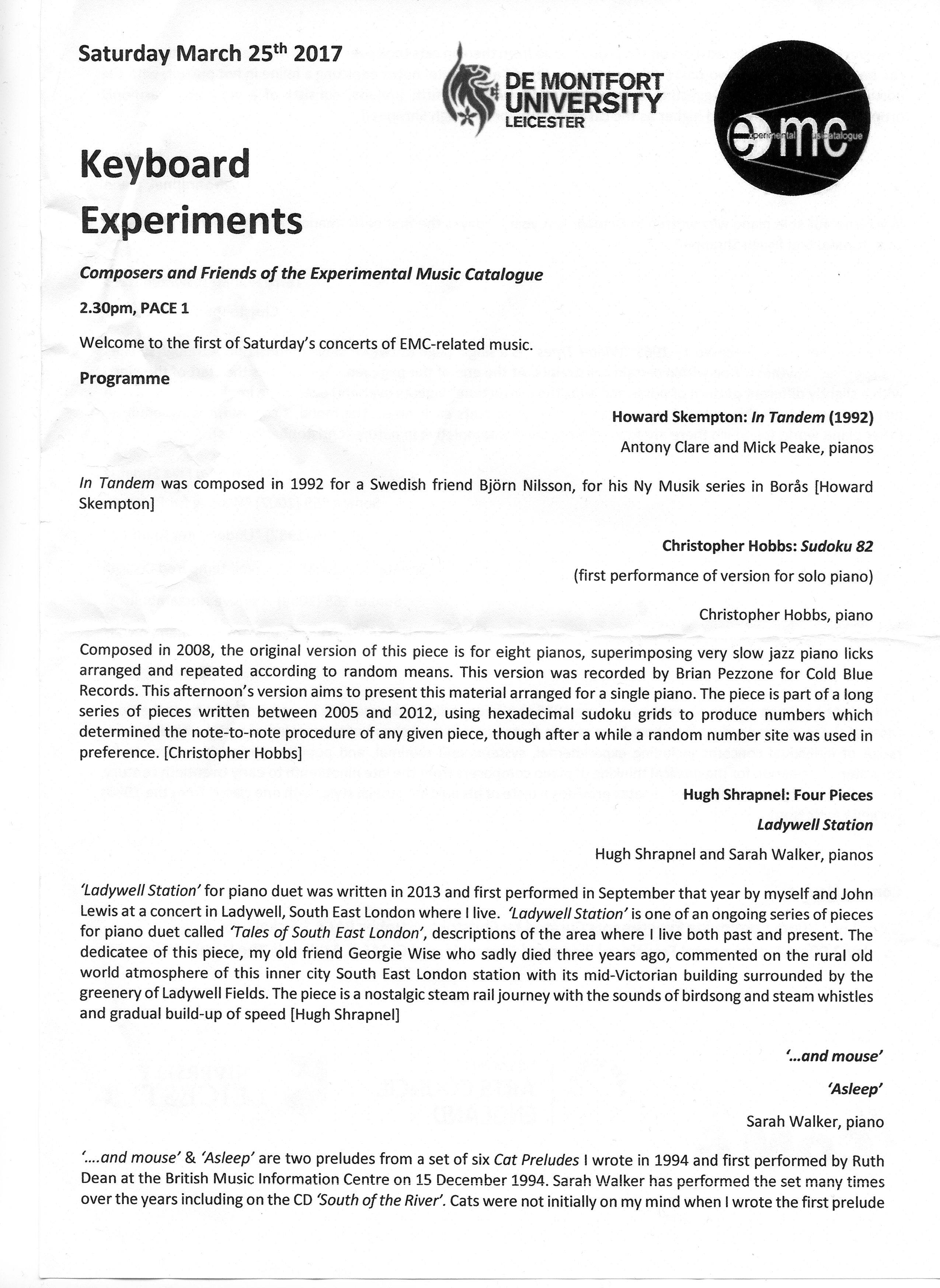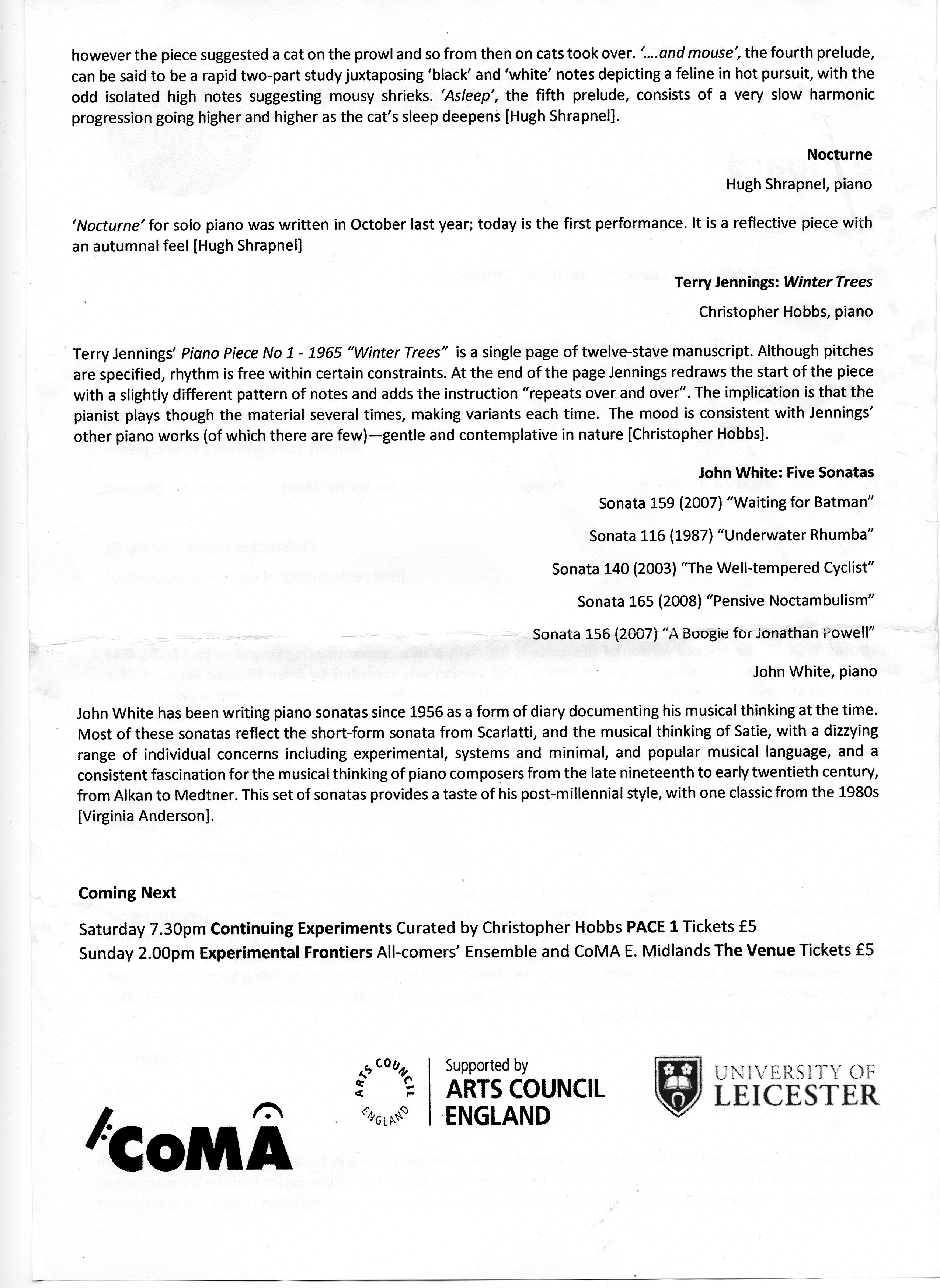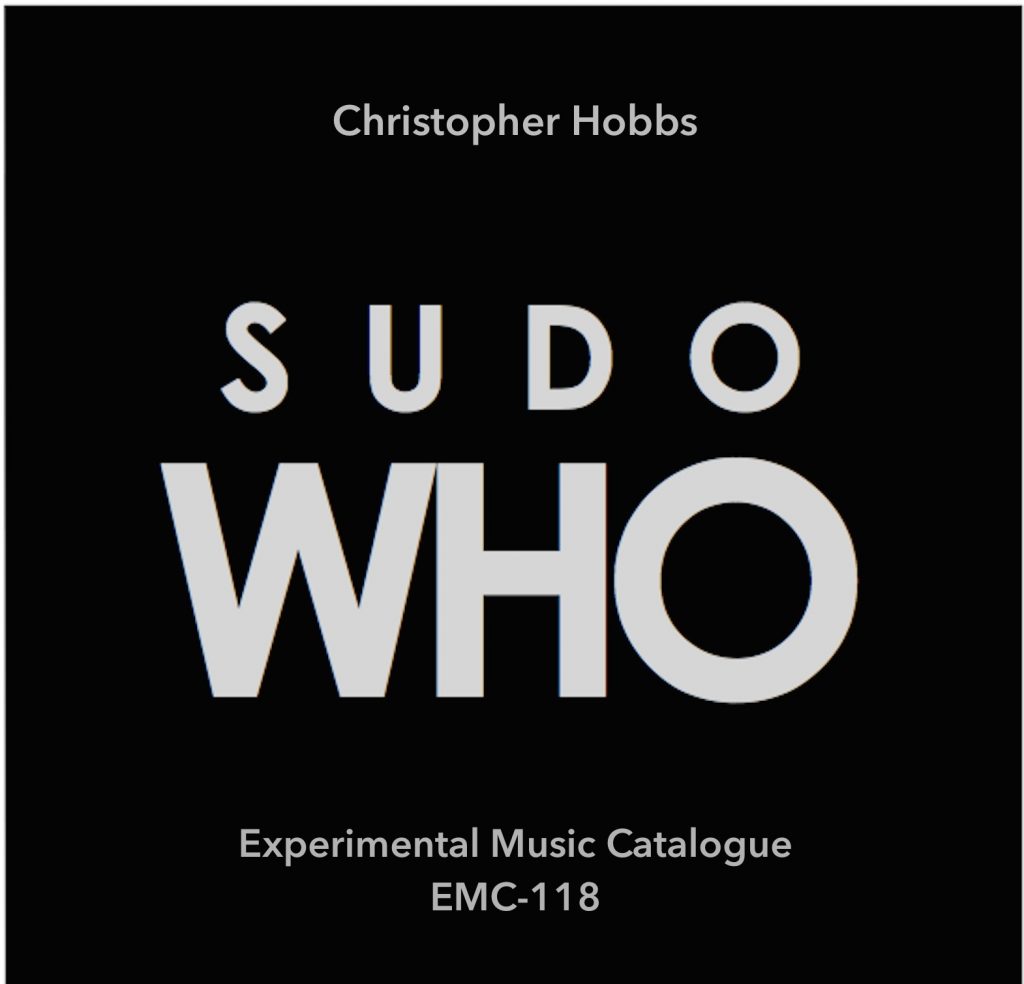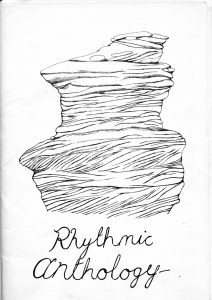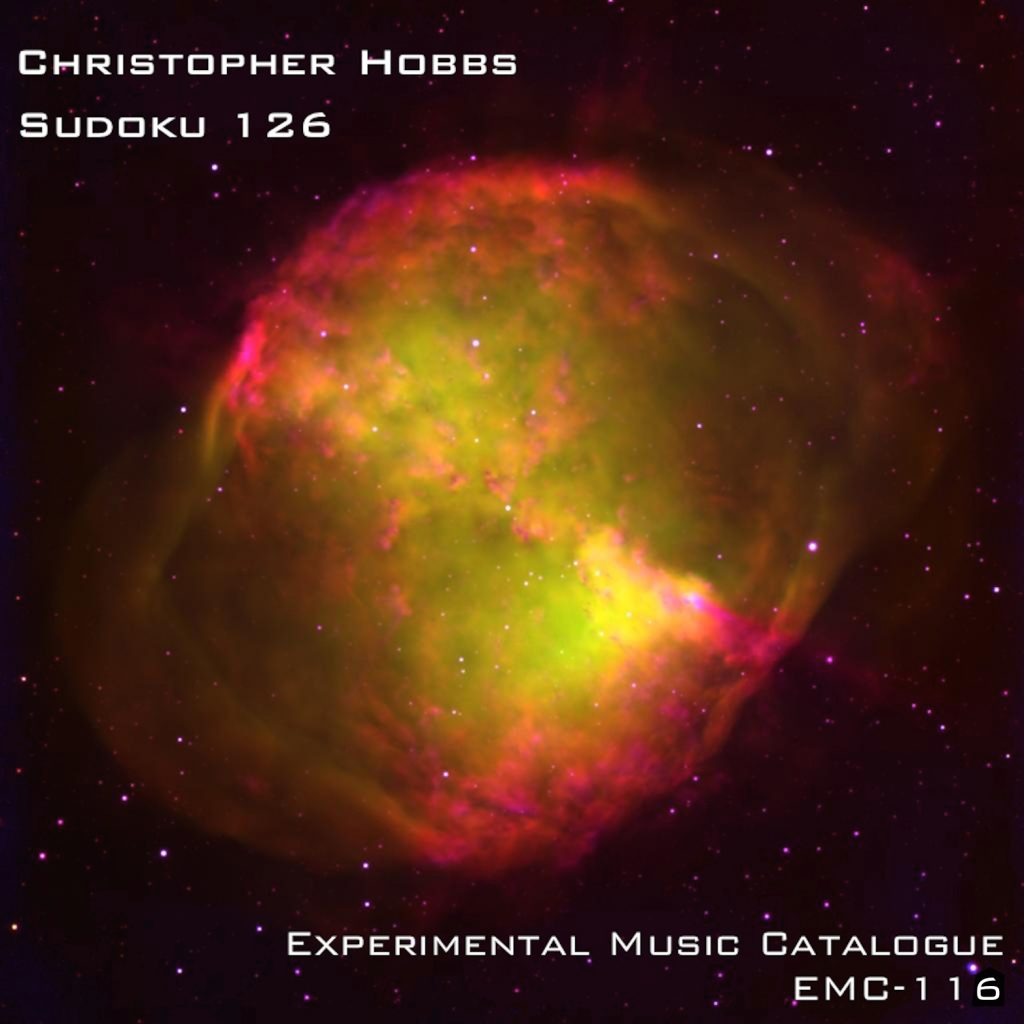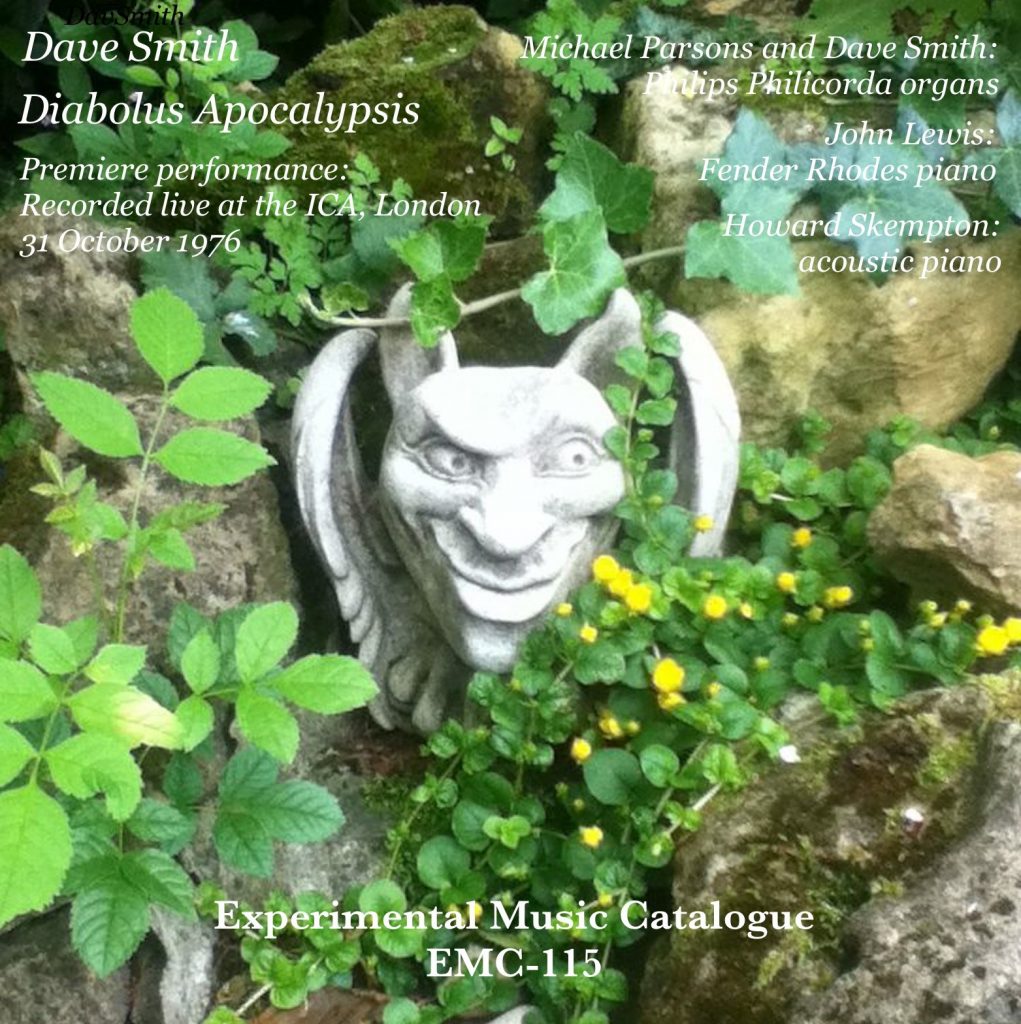Kyle Gann’s new book, Charles Ives’s Concord: Essays after a Sonata (University of Illinois Press), is out and is no doubt of great interest to all Ives fans, scholars, and pianists. On Jems, the peer-review journal hosted by the EMC, Chris Hobbs checks out this book, using fifty years of familiarity with the piece.* You can find his findings here in the review section of Jems.

*(A funny story: Hobbs performed the “Thoreau” movement for his entrance audition to the Royal Academy of Music in 1967. One of the examiners was the composer Alan Bush, who looked at the score and said something like, “Don’t know this piece. How am I going to know if you play a wrong note?” For the exact anecdote, buy Chris a beer and he’ll tell you…).
Category: EMC releases and publications
Here are the new publications and releases from the Experimental Music Catalogue
New to you! Sudoku 82!
Third time’s even more charming…. Announcing the release of the solo piano score of Christopher Hobbs’ Sudoku 82. How we got there is a tale….
Some years ago Chris Hobbs wrote Sudoku 82, a sparse, gentle, jazz-tinged piece for Apple GarageBand using mega sudoku systems processes. When Chris played it to me, I said, hey, that sudoku piece sounds like music from our favourite LA-based record label, Cold Blue Music. Cold Blue Music (http://coldbluemusic.com), run by the composer Jim Fox, presents some of the best music in what is commonly known as “West Coast” or “the new California school”. The music is cool, often sentimental, with composers such as Fox, Daniel Lentz, Michael Byron and Peter Garland, Rick Cox, and others. So with this hesitant, laid back quality, Sudoku 82 became known jovially around Hobbs Manor as the “Cold Blue Sudoku”. Then Jim Fox got involved….
As Chris tells it:
This piece has evolved over quite a long time. It began, as most of my Sudoku series do, as a GarageBand sound file, in May 2008. I used fragments of pre-existing jazz piano loops which I slowed down from their original tempo of around 126bpm to a very slow 20bpm. The chosen loops were arranged according to random means, deployed over eight tracks. Hearing the piece, the composer Jim Fox suggested the possibility of playing it live. I liked the idea, so this meant my notating the piece, transcribing the loops as they sounded when played at a very slow speed (chords which sound pristine at 126 can be quite ragged at 20!). Having done the work I sent it to Fox, who recorded it on his Cold Blue label, using the excellent pianist Bryan Pezzone to overdub all eight tracks. It appeared (as CB0033) in 2009.
Earlier this year I looked at the score and considered the possibility of reducing it to a single piano line; although it is nominally for eight pianos there is not too much going on; many of the chords contain the same notes and the slow tempo gives plenty of time to roll chords which have too many notes to be played at once. Every differing note in the original is present in the new version. While one has to forgo the stereo effect it is at least playable, and one piano is rather easier to obtain than eight!
Chris premiered this solo version at the EMC² Festival in March, as part of the “Keyboard Experiments” concert, an amazing afternoon recital with music by Howard Skempton, Chris Hobbs, John White, Hugh Shrapnel and Terry Jennings, played by Antony Clare and Mick Peake, Chris Hobbs, John White, and Hugh Shrapnel and Sarah Walker. We’re going to put up the concert footage on the experimusic YouTube channel as we can (we’ve just recently got the videos!), but here’s Chris, premiering Sudoku 82:
The score is great for study, for trying out at home (like a lot of slow post-minimalism, the physical technique is pretty simple, while the musicality is complex), and is much simpler to programme for live performance than the version with eight pianos. Sudoku 82 is available in PDF format for only £5, payable through PayPal—you’ll receive it by email for printing out. For ordering details, see here.
Alex Ross and the EMC!
We received a message from our good friend at Irritable Hedgehog, David McIntire, that Alex Ross, critic of the New Yorker, had a blog post about Erik Satie’s Le Fils des Étoiles. David McIntire informed Ross about Chris Hobbs’s work on the whole version of this piece, and Ross has added a note about Chris’s work and that the EMC has released not only the first ur text of Fils (Hobbs created an edition from the manuscript, correcting many errors in the Salabert published score), but also the first recording of the corrected edition.
Most recordings of this incidental music to the pageant/play by Joséphin Péladan consist just of Satie’s three Preludes to the play’s acts. These Preludes are pretty well-known and performed frequently by most pianists who specialise in Satie. However, Satie wrote continuous music to accompany the play’s acts, forming Satie’s longest piece of through-composed music. Chris Hobbs played the first modern performance of the entire piece (i.e., after Satie premiered it), and its first recording, on London Hall Records, in 1989. However, that first performance used the published score, with its various errors. After Chris finished the new edition (published some years before the Bärenreiter Urtext Edition), he recorded the corrected edition for the EMC.
You can read Ross’s blog post here. The score is available (with a preface by the Satie scholar Robert Orledge) on the EMC Piano Catalogue and the CD (EMC 103) can be found here. There is a discount if you order both the CD and score together.
EMC2 Programmes
The EMC² Weekend at De Montfort University, Leicester, was a great success, with talks, concerts, and a chance for all to perform great music in the tradition of the Experimental Music Catalogue. This weekend was the brainchild of Kieran O’Riordan, with Anna Claydon of CoMA (Contemporary Music for All), and performed with energy and much skill by the members of East Midlands CoMA, the improvisation groups CHA (Bruce Coates, Chris Hobbs, Virginia Anderson) and the South Leicestershire Improvisors Ensemble (Lee Allatson, Rick Nance, Virginia Anderson, Bruce Coates and Chris Hobbs), guest expert composers and performers including John White, Hugh Shrapnel, Sarah Walker, Chris Hobbs, Virginia Anderson, and Bruce Coates. Papers were given on related subjects from Virginia Anderson, Hilary Bracefield and Tim Bausch. Much material has been created from this event; much needs to be sifted, edited, and collated for publication. But we would like to share a little taste of the event as it went on:
Friday, 24 March:
Schedule:
Session 1: Setting the Scene
1.45 pm: Virginia Anderson, “The Experimental Music Catalogue: Past, Present, and Future”
Recording of live feed:
The Experimental Music Catalogue
Публикувахте от LUST в Петък, 24 март 2017 г.
Rehearsals and tea, then
4.45pm: Hilary Bracefield, “From Birmingham to Belfast: Improvising and experimenting with students”
(talk notes above for abstract and bio)
Recording of live feed:
Hilary Bracefield, ‘From Birmingham to Belfast: improvising and experimenting with students’
Публикувахте от Experimental Music Catalogue в Петък, 24 март 2017 г.
Evening concert, MTI Goes EMC²: Students and staff from DMU’s music technology department play music.
Saturday, 25 March:
Began with rehearsals for allcomers and tea, then lunch, then:
1.30 pm: Panel chaired by Sarah Walker, including Virginia Anderson, Chris Hobbs, John White and Hugh Shrapnel
Recording of live feed:
Panel Chaired by Sarah Walker, including Virginia Anderson, Chris Hobbs, John White and Hugh Shrapnel.
Публикувахте от Experimental Music Catalogue в Събота, 25 март 2017 г.
2.30: Concert 2: Keyboard Experiments
Programme:
Video awaiting processing, so we’ll have to wait for good quality clips, and for Howard Skempton’s In Tandem, performed by Antony Clare and Mick Peake.
However here are links to very short clips:
Chris Hobbs, premiere of solo version of Sudoku 82:
We're hoping to bring you not only the talking portion of the EMC2 weekend, but also audio and perhaps video records of these historic concerts. In the meantime, here are a few clips from the lunchtime Keyboard Experiments concert: first, a few seconds of Chris Hobbs, premiering the first solo version of his Cold Blue Sudoku 82.
Публикувахте от Experimental Music Catalogue в Неделя, 26 март 2017 г.
Hugh Shrapnel and Sarah Walker, playing Hugh Shrapnel, Ladywell Station
We're hoping to bring you not only the talking portion of the EMC2 weekend, but also audio and perhaps video records of these historic concerts. In the meantime, here are a few clips from the lunchtime Keyboard Experiments concert: Here is Hugh Shrapnel and Sarah Walker performing Hugh's Ladywell Station.
Публикувахте от Experimental Music Catalogue в Неделя, 26 март 2017 г.
Hugh Shrapnel, Cat Preludes, “…and mouse”, performed by Sarah Walker:
We're hoping to bring you not only the talking portion of the EMC2 weekend, but also audio and perhaps video records of these historic concerts. In the meantime, here are a few clips from the lunchtime Keyboard Experiments concert: Sarah Walker playing "…and mouse" from Hugh Shrapnel's Cat Preludes.
Публикувахте от Experimental Music Catalogue в Неделя, 26 март 2017 г.
Also “Asleep”, from Cat Preludes
Here is Shrapnel playing his Nocturne:
We're hoping to bring you not only the talking portion of the EMC2 weekend, but also audio and perhaps video records of these historic concerts. In the meantime, here are a few clips from the lunchtime Keyboard Experiments concert: Hugh Shrapnel playing his Nocturne.
Публикувахте от Experimental Music Catalogue в Неделя, 26 март 2017 г.
Chris Hobbs, with Terry Jennings’ Winter Trees:
We're hoping to bring you not only the talking portion of the EMC2 weekend, but also audio and perhaps video records of these historic concerts. In the meantime, here are a few clips from the lunchtime Keyboard Experiments concert: Chris Hobbs performing Terry Jennings' Winter Trees.
Публикувахте от Experimental Music Catalogue в Неделя, 26 март 2017 г.
and John White, here playing most of Sonata 159, “Waiting for Batman”:
We're hoping to bring you not only the talking portion of the EMC2 weekend, but also audio and perhaps video records of these historic concerts. In the meantime, here are a few clips from the lunchtime Keyboard Experiments concert: John White performing his 2007 Piano Sonata 159, "Waiting for Batman".
Публикувахте от Experimental Music Catalogue в Неделя, 26 март 2017 г.
At 5 pm (after more rehearsals), Tim Bausch gave a paper, “Repetition as Catalyst: The Process of Creation in the Music of Alvin Lucier.”
Tim Bausch, ‘Repetition as Catalyst: The Process of Creation in the Music of Alvin Lucier’
Публикувахте от Experimental Music Catalogue в Събота, 25 март 2017 г.
We will get to the evening concert, Continuing Experiments, in another post.
Life at Wigmore Hall
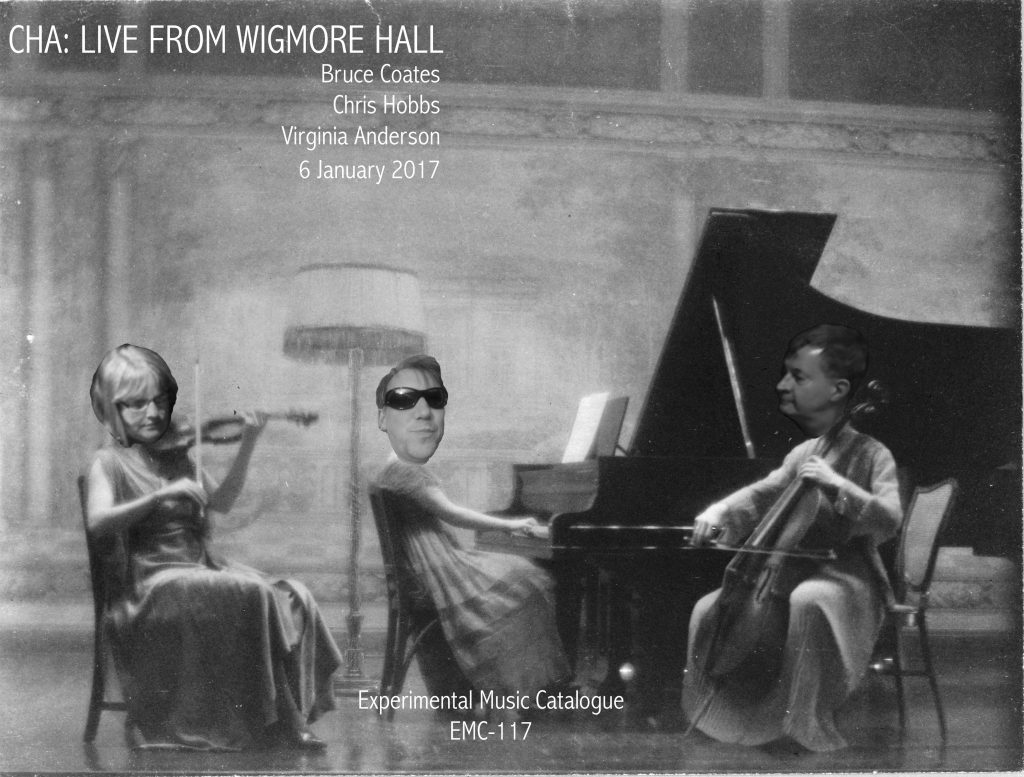
One of the most gratifying features of being on the Experimental Music Catalogue staff, and of researching British and West Coast American free improvisatory, experimental, minimal, and postminimal music, is that it is often so fun, due to an aesthetic criteria that I have described elsewhere as “humour as a noble emotion.” Instead of thinking that all good music must be weighty, scientific, made for the ages, a lot of these composers and performers, well, like to have a good laugh and use their full talents and experience to write top-quality music that is funny.
And the newest release on EMC Bandcamp from CHA (an acronym standing for Bruce COATES, Chris HOBBS, and me, Virginia ANDERSON)—CHA: Live from Wigmore Hall—began as a bit of banter. A couple of years ago, Chris Hobbs and I were driving along small country roads around Shropshire and Herefordshire, when we spotted a village sign reading “Wigmore”. Chris said, “I wonder if they have a village hall. We could play there and bill it as ‘Live from Wigmore Hall’!” This was quite a giggle: for anyone concerned with music in Britain, London’s Wigmore Hall is perhaps the premiere venue for chamber music in Britain . Built at the turn of the last century, it features stunning acoustics and hosts a weekly concert broadcast live by the BBC. Recordings issued as “Wigmore Hall Live” include works by Mozart, Beethoven, Tippett, Schubert, Britten, Brahms. To think that CHA would perform at such a bastion of classical masterworks was ludicrous. So we kept the idea in mind….
What happened—the recording, the album art, the release—has much to do with the culture of free improvisation and its “personality” and the way that CHA arose and works as a trio.
Music is Painful: The personality of free improvisation
The culture of free improvisation (meaning non-notated, usually non-tonal spontaneous performance by one or more musicians) has always seemed to me to resemble a family reunion. People assemble and interact. They may know each other well and for a long time; it may be their first meeting. Each participant brings in his or her own personality and skills to the meeting. Some players may interact with each other at their first meeting as if they had known each other their whole lives. Other players need to work with each other, to sound each other out, before they find their mix. Some players are like the favourite uncle, full of witty banter and jolly games. Some players—the free spirits—may make musical contributions that are spiritual, philosophical, or arcane (the pioneering group AMM, whose name is an acronym that is secret, has always cultivated an aura of mystery). Some players resemble an unpleasant second cousin, loudly and continuously braying out their prejudices, so that no one else can make conversation (such as the player who brought his homemade fretless bass to improvisations to make ceaseless unmusical booms). Then there are the serious souls, depicting the angst of the world both physically through their contorted bodies, and sonically. For them, improvisation is a serious business, and music is painful.
However, deep personal expression of angst is only one emotional affect that can be delivered through musical improvisation. The late Lol Coxhill was a particularly versatile performer of all sorts of free improvisation, jazz, indie popular music, and musical theatre, much of it full of delight rather than pain, and some of it laugh-out-loud funny. The Art Ensemble of Chicago, billing their concerts as “Great Black Music—Ancient to the Future” presented a panoply of styles and moods that changed from concert to concert. As one of the most “experimental” of Afrocentric bands, their use of toys, and Lester Bowie’s “scientific” experiments are perhaps closest to the experimental music in Britain that we enjoy here at the EMC. Bowie wore a white lab coat on Art Ensemble performances—a clear symbol of his role as “experimenter”. And Bowie’s exploration and ennoblement of the mundane, even tacky, corners of popular music reminds me of that great founding experimentalist, Erik Satie. His absolutely delightful album Fast Last! (1974), one of his non-Art Ensemble projects, mixed the track “F Troop Rides Again”, a meditation on the theme of one of the silliest of 1960s American comedy series, with the Broadway standard “Hello Dolly” and “Lonely Woman”, a haunting piece by Ornette Coleman. This equality of the deeply silly, the old standard, and the complex classic is reminiscent of much British experimental music since the late 1960s, especially the music of John White (whose titles and pieces can be simultaneously deep and silly), and it may lie in the deep subconscious of CHA improvisation. That is, if CHA, a spontaneous ensemble, actually stopped to think of it.
CHA: The Road to Wigmore
What CHA did think about was how to set up the joke. I found that, yes, indeed, there was a village hall at Wigmore that could be hired. So we booked a couple hours at the hall for 6 January and, on a day of flooding and pouring rain, Chris, Bruce and I met at the Village Hall. We brought our instruments, sound objects, toys and other materials. We also brought a picnic hamper filled with meat and cheese sandwiches on rye and a large bottle of Belgian beer.

This Wigmore Hall is more versatile than London’s Wigmore Hall, as it hosts keep-fit classes, meetings, and other events of interest to the villagers.

The decor is also somewhat different to that of the London Wigmore Hall, which is noted for its interior design and acoustics.
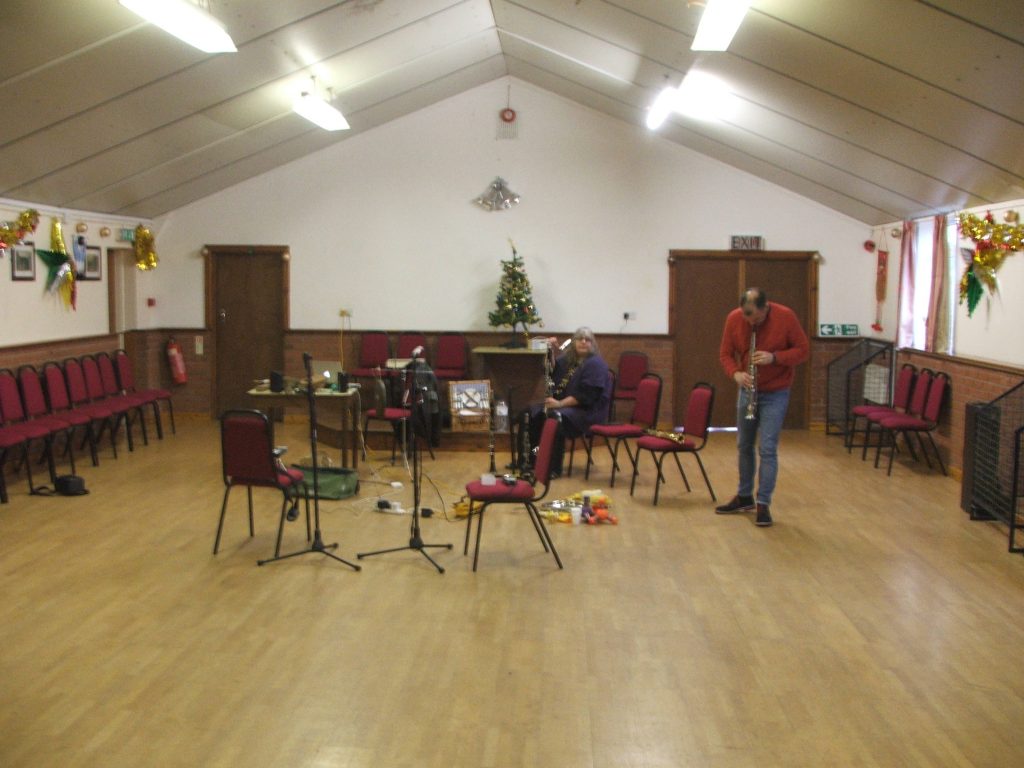
Wigmore Village Hall was decorated when we visited on 6 January with the last of the Christmas decorations. The hall’s acoustics are not bad, though unlike London, the Village Hall has no piano.
The Wigmore Hall recording
Both Chris and Bruce brought portable digital recording devices, recording in WAV format, so that there was a back-up. In the end, we used Bruce’s recording, because Bruce had better microphones. We set up the instruments, which included, for Chris, an Organetta (small reed organ), percussion, laptop with GarageBand loops, some toy noisemakers, and a radio. Bruce brought his saxophones (including a lurid plastic alto) and other sound sources, including dog toys, a metal thali, and comedy rubber animals. I brought three clarinets and stuck mainly to playing them, with only the occasional duck call.
The actual improvisation, which can be heard on the EMC Bandcamp page, is hard to describe in words. Basically, the nature of the instrumentation and the personalities of the trio gives the music a lighter, airier quality that a lot of free improv. There is more space, more short silences that many groups. And it is perhaps less aggressive than the so-called “sync or swarm” improvisation that is more commonly written about. There is a tendency toward a higher tessitura, as Bruce tends to favour his soprano and sopranino saxes, which I often match with my Eb sopranino clarinet. Chris tended to move around the room, to the dais, with its Christmas tree and his Organetta and radio; to the middle of the room, with the laptop and gong; and then carrying small percussion and his pennywhistle toward the entrance at the back of the hall. In the third set, “Consumption”, the combination of the little sax, little clarinet, and Chris’s pennywhistle set up a magnificent subharmonic drone that supported the high sounds, which, like so many subharmonics, was not picked up by the recording. Sometimes the sound world is jagged, but concords, even modality can show up. And of course, there are the toys: rubber chickens and sheep; a strange, squeaking dog toy in the form of a jack.
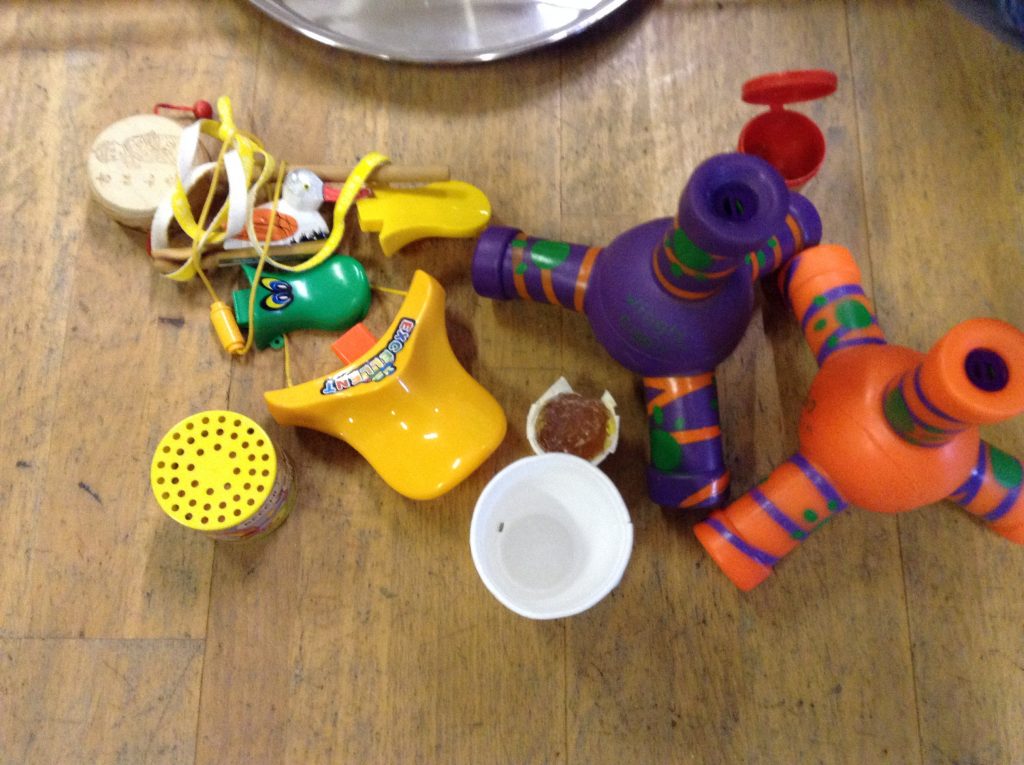
We decided that as much of the actual sounds that the microphones did pick up of the Wigmore Village Hall performance should be included, which is why, at the end of the first set, “Interruption”, a man’s voice can be heard. This “person from Porlock” (as Samuel Taylor Coleridge’s unwelcome visitor came to be known) wished to inform us that he and a couple other people would be using the smaller room of the hall to have a conversation. I pointed to the microphones, said, “We’re recording.” He apologized and exited. The second set, “Resumption”, and third set proceeded without further disruption, as our contented conversation at the end of “Consumption” shows. “Consumption” refers to the contents of the CHA picnic basket.
Producing the album
Bruce invented the titles after the recording and cover art had been made; indeed, after the liner notes were already in a completed draft. Titles for free improvisation tracks are perhaps the most arbitrary of all titles in music. There is no structure in free improvisation that would suggest a generic name like “sonata”; the mood or emotional “affect”, should there be one, often emerges only in real time. Many improvisers choose poetic, often obscure titles, such as “Later During a Flaming Riviera Sunset”, and “Ailantus Glandulosa” on AMM’s AMMmusic (1966). CHA has no such mystical identity: we have been primarily identified by pictures of toys (the small animal heads made by Bruce’s father, the artist Andrew Coates, which graced the promotional material for our 2013 concert at the Engine House, Manchester) or tea cups and mugs (a play on the British slang term for tea, “cha”).

This time, I wanted something that tied in with the Wigmore Hall association, so Bruce designed the cover using a copyright-free image of a piano trio of women from sometime in the 1920s. We saw, we giggled, we waited for someone to counsel for something more momentous to go with our great work for the ages, and when that objection never arose, we released CHA: Live from Wigmore Hall.
CHA, CHA, CHA….
So ends this explanation of the first CHA album. It is always a mistake to explain a joke, but since this was an in-joke between our trio, I thought I would provide some background, not just to the recording, but where it sits as experimental practice among more traditionally-minded modern music. Music does not have to be painful, though of course it can be; music can be pretty—it can be fun. I can’t wait for the next CHA adventure.
CHA: Live From Wigmore Hall
CHA—Bruce Coates, Chris Hobbs, and Virginia Anderson—is the trio from the Midlands of England devoted to new sounds and combination of sounds, and a fun, fresh approach to non-tonal (or part-tonal) free improvisation. This NEW album, available on the EMC Bandcamp page, finds these adventurers recording at Wigmore Hall….
Well, maybe not THE Wigmore Hall, London home of classical chamber music, but a Wigmore Hall. Wigmore Village Hall, Herefordshire, in fact.
This album of three sets is laid down unedited, as played by CHA live. The three sets include:
Interruption: refers to the ending, when a man entered to say that he and his friends would be using the other room in the hall for a conversation.
Resumption: is self-explanatory.
Consumption: refers to liquid contents of the CHA picnic basket.
So, get a nice cup o’ CHA now on Bandcamp: http://bandcamp.experimentalmusic.co.uk/album/cha-live-from-wigmore-hall £6 or more for the album and cool pdf liner notes, or £2 a track!
(Thanks to Bruce Coates for the cool cover design!)
sudoWHO!
A new EMC Recording single release for this grey Sunday. Christopher Hobbs’ SudoWho (EMC-118). Chris writes of this piece:
SudoWho was made in November 2007. In its original DVD version it mixed audio and visuals from the outtakes of early Dr Who episodes with audio taken from NASA and GarageBand space sound effects using chance operations to determine placement of the clips. This version presents the sound-track only, but it is my belief that it stands on its own well enough.
You can get this SudoWho from the EMC Bandcamp page for only £1 (or what you will!): http://bandcamp.experimentalmusic.co.uk
Announcing the return of the EMC Rhythmic Anthology
New on the EMC:
The re-release of the original EMC Rhythmic Anthology, originally from 1973.
OEMC0040. Hugh Shrapnel/Gavin Bryars/Jon Gibson/Christopher Hobbs/Michael Nyman/Michael Parsons. Rhythmic Anthology.
Pdf facsimile of the original document. 40 pp. £8.50.
One of the great Anthologies from the Experimental Music Catalogue’s first incarnation. Rhythmic Anthology includes Bells, by Hugh Shrapnel (a large page that formed the inside cover of the original), The Squirrel and the Ricketty-Racketty Bridge and Pre-Mediaeval Metrics by Gavin Bryars, 30’s by Jon Gibson, Exercises for Percussionists by Christopher Hobbs, Bell Set 1 by Michael Nyman, and Rhythm Studies I and II for piano and Rhythm Studies for percussion by Michael Parsons. This Anthology includes important—indeed, essential—scores in experimental and minimalist music history (including the must-have works by Bryars, Gibson, Nyman, and Parsons). All produced with the full permission of all composers and their publishers, with a facsimile of the original cover, an iconic design by Angela Bryars.
For how to order, go here, and punch the link to the Classic EMC Anthologies page: http://experimentalmusic.co.uk/wp/emc-catalogue-list/
On Bandcamp: Hobbs goes “spacey”!
New Release: Christopher Hobbs’ Sudoku 126 (2009), one of his Sudoku series, in which Sudoku mega puzzles determine sounds made using the Apple Garageband program. Hobbs tells it like this:
Sudoku 126 dates from 2009. It is one of a series in which long held notes, encountering each other on the same track, interact in unpredictable ways, causing wild fluctuations of pitch. In this Sudoku there are eight tracks, each containing eight notes which diminuendo over a period of four minutes. The choice of pitch and time of initiation within the track were determined by chance. The accompanying image is meant to suggest the “spacey” nature of the piece.
This Sudoku is scheduled to appear as an installation at an upcoming study day at Coventry University (more on that when we know more).
In the meantime, listen for free or download to have throughout the space-time continuum for £3 (or more if you like) for just under 40 minutes of outer-space goodness. You can find it here: http://bandcamp.experimentalmusic.co.uk/album/sudoku-126
The devil made us do this…
Another great archive recording on EMC Bandcamp: Dave Smith’s Diabolus Apocalypsis, recorded live at the ICA, 31 October 1976, by Richard Ascough. Starring Michael Parsons and Dave Smith, playing Philips Philicorda electric organs; John Lewis, playing Fender Rhodes electric piano; and Howard Skempton, playing the ICA piano, which seems to have been an appallingly ramshackle affair. As Dave Smith told us:
“The piano itself was a legless affair resident in the ICA: I remember it was perched on metal beer barrels. It of course had no pedals which was fine for the piece. Howard managed to bust a string part of the way in . . .”
This is from the same ICA concert as Smith’s Moderation in Nothing, EMC-113, which we uploaded a while back. Like Moderation in Nothing, we’re releasing this as an EP single (23 minutes). The performers here form the entire group of composers whose music was on this concert — a rare collaboration of two of the great English systems music duos of that time, Parsons/Skempton, and Smith/Lewis (the other duo being Hobbs/White). This single is an archival gem, and as such has some limited distortion from the shock of the instruments on the live recording. You can listen online for a limited time for free, and can own it for £3 or over (a gift to help us continue to keep the EMC going and 10% to the composer in royalties). A purchase comes with a pdf download of a facsimile of the concert programme and a flyer for the series.
Here is the link: http://bandcamp.experimentalmusic.co.uk/album/diabolus-apocalypsis
The devil you say? Oh, yes, the devil we say!

